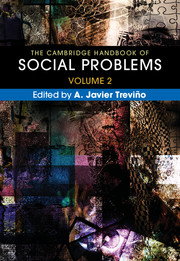Book contents
- The Cambridge Handbook of Social Problems
- The Cambridge Handbook of Social Problems
- Copyright page
- Contents
- About the Contributors
- Introduction
- Part I Problems Related to Health, Safety, and Security
- Chapter 1 Illness and Health Care
- Chapter 2 Mental Illness and Social Problems
- Chapter 3 Substance Abuse
- Chapter 4 Epidemics, Pandemics, and Outbreaks
- Chapter 5 Disaster as Social Problem and Social Construct
- Chapter 6 Surveillance
- Chapter 7 Domestic Spying: A Historical-Comparative Perspective
- Chapter 8 Computer Hacking as a Social Problem
- Chapter 9 War and Militarism
- Chapter 10 The Social Problem of Terrorism
- Chapter 11 Genocide
- Part II Problems Related to Crime and Violence
- Part III Problems of Global Impact
- Index
- References
Chapter 5 - Disaster as Social Problem and Social Construct
from Part I - Problems Related to Health, Safety, and Security
Published online by Cambridge University Press: 16 March 2018
- The Cambridge Handbook of Social Problems
- The Cambridge Handbook of Social Problems
- Copyright page
- Contents
- About the Contributors
- Introduction
- Part I Problems Related to Health, Safety, and Security
- Chapter 1 Illness and Health Care
- Chapter 2 Mental Illness and Social Problems
- Chapter 3 Substance Abuse
- Chapter 4 Epidemics, Pandemics, and Outbreaks
- Chapter 5 Disaster as Social Problem and Social Construct
- Chapter 6 Surveillance
- Chapter 7 Domestic Spying: A Historical-Comparative Perspective
- Chapter 8 Computer Hacking as a Social Problem
- Chapter 9 War and Militarism
- Chapter 10 The Social Problem of Terrorism
- Chapter 11 Genocide
- Part II Problems Related to Crime and Violence
- Part III Problems of Global Impact
- Index
- References
Summary
There are few examples of studies that view disasters through a social problems lens. Disasters are seldom constructed as social problems, and when they are, such collective definitions typically follow the occurrence of major disasters that are defined as revealing policy deficits. While recognizing the importance of symbolic processes surrounding disaster-related phenomena, most research proceeds from a realist stance that takes the occurrence and consequences of disasters as givens. Too little attention has been paid to how hazards and disasters are discursively framed and how their consequences are produced through institutional and elite action. At the same time, both research and real-world developments illustrate the extent to which claims regarding the genesis of disasters, the nature of the harms disasters produce, and responsibility for causing and ameliorating such harms shift and evolve. Constructions of disaster and other perils reveal the power dynamics and reigning ideologies within the societies in which they occur.
Information
- Type
- Chapter
- Information
- The Cambridge Handbook of Social Problems , pp. 79 - 94Publisher: Cambridge University PressPrint publication year: 2018
References
Accessibility standard: Unknown
Why this information is here
This section outlines the accessibility features of this content - including support for screen readers, full keyboard navigation and high-contrast display options. This may not be relevant for you.Accessibility Information
- 9
- Cited by
